The Black Sicklebill (Epimachus fastosus) is one of the most remarkable and unique members of the Bird-of-Paradise family (Paradisaeidae). Known for its elongated tail, iridescent plumage, and spectacular courtship display, this species is a true marvel of evolution. It is found exclusively in the mountain forests of New Guinea, where it thrives in high-altitude habitats.
This article provides a comprehensive and in-depth exploration of the Black Sicklebill, covering its taxonomy, physical characteristics, behavior, diet, habitat, reproduction, and conservation status. Whether you are a bird enthusiast, wildlife researcher, or simply curious about exotic birds, this guide will offer detailed insights into one of nature’s most fascinating creatures.
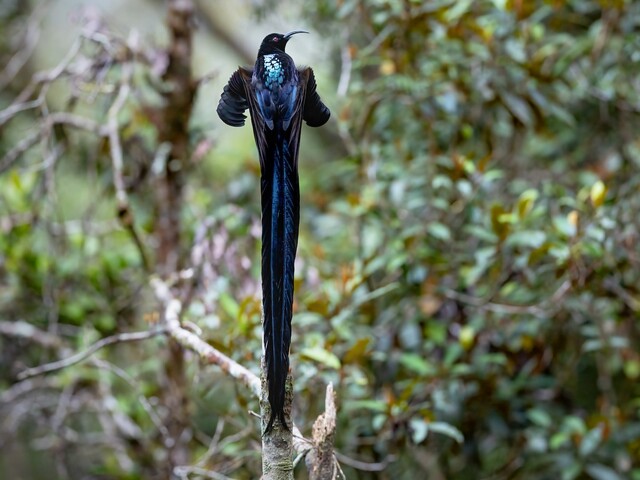
Kingdom: Animalia
Phylum: Chordata
Class: Aves
Order: Passeriformes
Family: Paradisaeidae (Birds-of-Paradise)
Genus: Epimachus
Species: Epimachus fastosus
Genus (Epimachus): The name means “equipped for battle,” referencing the loud, machine-gun-like vocalizations of this genus.
Species (fastosus): The Latin word means “proud” or “magnificent,” aptly describing the striking appearance of the male Black Sicklebill.
Common Name: “Black Sicklebill” refers to the bird’s distinctive long, curved bill, resembling a sickle.
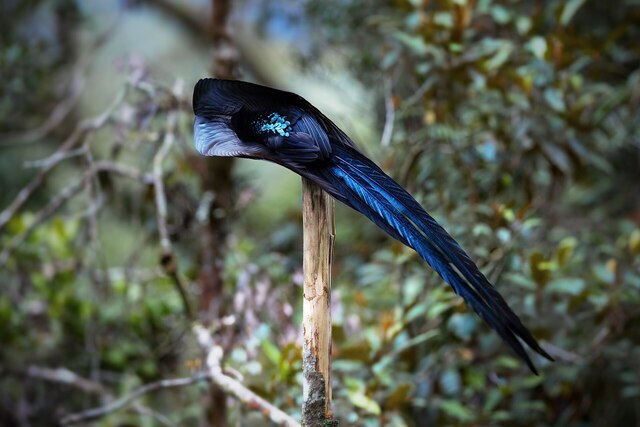
The Black Sicklebill is the second-longest Bird-of-Paradise, surpassed only by the Ribbon-tailed Astrapia.
Male length (including tail): Up to 110 cm (43 in)
Male body length (excluding tail): 61 cm (24 in)
Female length: 53 cm (21 in)
The male Black Sicklebill is known for its iridescent black plumage, which reflects stunning blue and green hues in certain light conditions.
Head: Glossy black with a long, slightly curved silver-gray bill and bright yellow mouth lining.
Eyes: Surrounded by iridescent blue-green scales, forming a striking contrast with its deep crimson red iris.
Body and Wings: Primarily black with metallic blue highlights.
Tail: Exceptionally long, displaying blue iridescence, especially in the central tail feathers.
Chest Feathers (Courtship Display): Features two large, black, fan-shaped chest plumes with iridescent blue-green tips, forming a distinctive “comet” shape when spread.
The female Black Sicklebill is much less extravagant, with an appearance designed for camouflage.
Coloration: Olive-brown upper body, orange-brown crown, and a pale cream underside marked with dark horizontal barring.
Tail: Long, but shorter and less striking than the male’s.
Eyes: Brown, differentiating her from the similar-looking female Brown Sicklebill (Epimachus meyeri), which has white eyes.
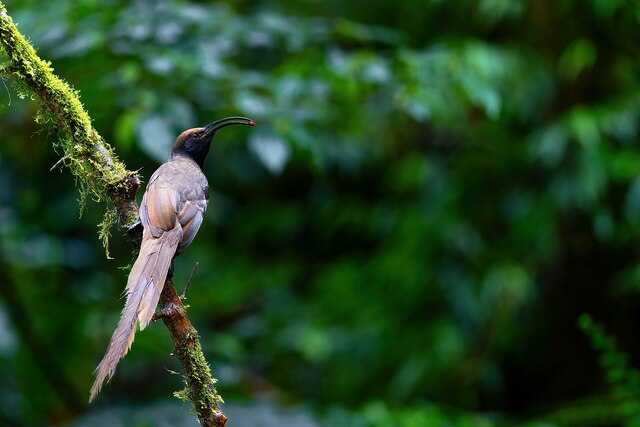
The Black Sicklebill’s call is highly distinctive and can be heard over long distances in dense mountain forests.
The primary call is a loud, rapid, bubbling "kwit-it kwit-it" sound, resembling machine-gun fire.
This powerful vocalization helps males establish territory and attract potential mates.
The Black Sicklebill is endemic to New Guinea, primarily found in the central mountain ranges and the Vogelkop Peninsula.
It inhabits montane and subalpine forests at elevations between 1,800 and 2,150 meters (5,900 – 7,100 feet).
Prefers dense mountain forests, particularly areas with tall trees and abundant foliage.
Often found in undisturbed primary forests, but can sometimes be seen in selectively logged forests.
The Black Sicklebill is an omnivorous bird, consuming both plant and animal matter.
Fruits: Various native rainforest fruits, making up a significant portion of its diet.
Insects and Small Vertebrates: Includes beetles, caterpillars, spiders, frogs, and small lizards.
Foraging Strategy:
Typically forages alone but occasionally joins mixed-species feeding flocks.
Uses its curved bill to probe into bark crevices, leaf litter, and moss in search of prey.
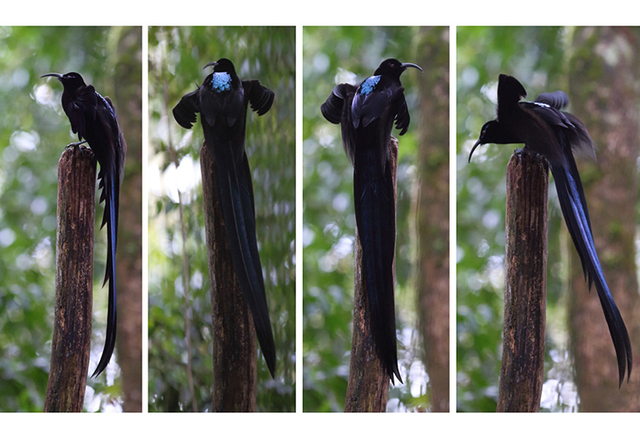
Like most Birds-of-Paradise, the Black Sicklebill is polygynous, meaning that a male mates with multiple females while the female handles all parental duties.
Males select a high perch and call loudly to attract females.
When a female arrives, the male:
Unfolds his chest plumes, forming a large, fan-shaped "comet" display.
Leans forward and bows while spreading his wings.
Performs an aerial display, hovering and producing a clapping sound with wing beats.
Females build nests in tree branches, using leaves and twigs.
The female incubates the eggs alone and provides all parental care until the chicks fledge.
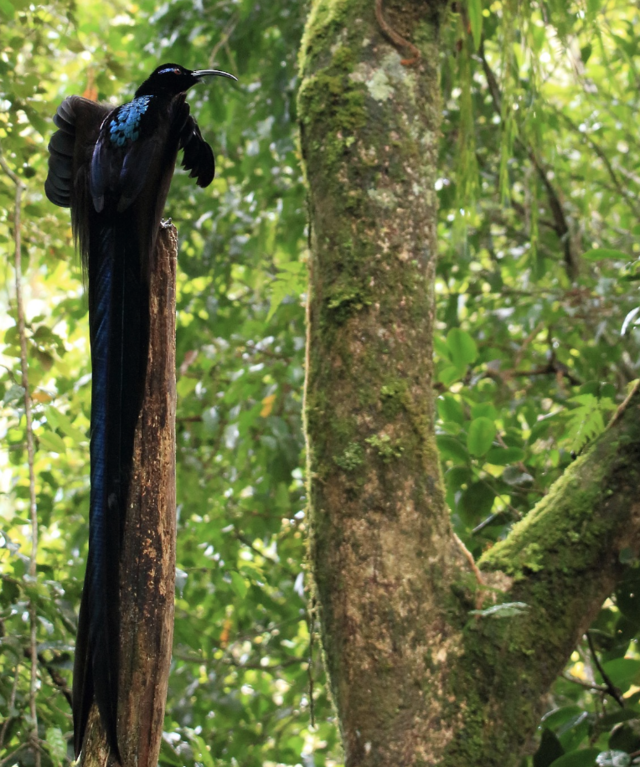
The Black Sicklebill has been observed hybridizing with the Arfak Astrapia (Astrapia nigra), resulting in two previously thought "new species":
Elliot’s Sicklebill (Epimachus ellioti)
Astrapimachus (Astrapimachus astrapioides)
While most ornithologists recognize these as hybrids, some believe Elliot’s Sicklebill could be a distinct species.
The total population is estimated between 2,000 and 10,000 individuals.
Habitat Destruction: Logging and deforestation for agriculture are major threats.
Hunting: In some areas, locals hunt them for their long tail feathers and meat.
IUCN Status: Listed as “Least Concern”, but with a declining population trend.
CITES Listing: Appendix II, meaning international trade is regulated.
The Black Sicklebill (Epimachus fastosus) is one of the most stunning and mysterious Birds-of-Paradise. With its elongated tail, iridescent plumage, and elaborate courtship rituals, it stands as a testament to nature’s creativity. While its population faces challenges, continued conservation efforts will ensure this magnificent species continues to thrive in New Guinea’s rainforests.
animal tags: Paradisaeidae
We created this article in conjunction with AI technology, then made sure it was fact-checked and edited by a Animals Top editor.